Kotlin版图解FunctorApplicative与Monad
Posted Kotlin
tags:
篇首语:本文由小常识网(cha138.com)小编为大家整理,主要介绍了Kotlin版图解FunctorApplicative与Monad相关的知识,希望对你有一定的参考价值。
本文原文链接较多,建议点击文末“阅读原文”查看。
本文是从 Haskell 版 Functors, Applicatives, And Monads In Pictures 翻译而来的 Kotlin 版。 我同时翻译了中英文两个版本,英文版在这里。
与从 Swift 版翻译而来的 Kotlin 版不同的是,本文是直接从 Haskell 版原文翻译而来的。
这是一个简单的值:
我们也知道如何将一个函数应用到这个值上:

这很简单。 那么扩展一下,我们说任何值都可以放到一个上下文中。 现在你可以把上下文想象为一个可以在其中装进值的盒子:
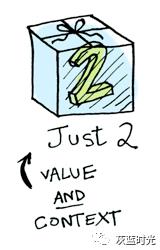
现在,将一个函数应用到这个值上时,会根据上下文的不同而得到不同的结果。 这就是 Functor、 Applicative、 Monad、 Arrow 等概念的基础。 Maybe 数据类型定义了两种相关上下文:
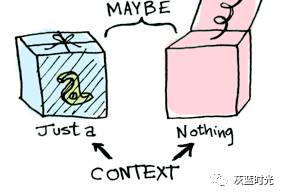
sealed class Maybe<out T> {
object `Nothing#` : Maybe<Nothing>() {
override fun toString(): String = "Nothing#"
}
data class Just<out T>(val value: T) : Maybe<T>()
}很快我们就会看到将函数应用到 Just<T>上 还是应用到 Nothing# 上会有多么不同。 首先我们来说说 Functor 吧!
注: 这里用
Nothing#取代原文的Nothing,因为在 Kotlin 中Nothing是一个特殊类型,参见 Nothing 类型。 另外 Kotlin 有自己的表达可选值的方式,并非使用Maybe类型这种方式,参见空安全。
Functor
当一个值被包装在上下文中时,你无法将一个普通函数应用给它:
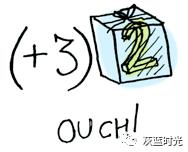
这就轮到 fmap 出场了。 fmap 翩翩而来,从容应对上下文。 fmap 知道如何将函数应用到包装在上下文中的值上。 例如,你想将 {it + 3} 应用到 Just(2)上。使用 fmap 如下:
> Maybe.Just(2).fmap { it + 3 }
Just(value=5)
嘭! fmap 向我们展示了它的成果。 但是 fmap 怎么知道如何应用该函数的呢?
究竟什么是 Functor 呢?
在 Haskell 中 Functor 是一个类型类。 其定义如下:

在 Kotlin 中,可以认为 Functor 是一种定义了 fmap 方法/扩展函数的类型。 以下是 fmap 的工作原理:

所以我们可以这么做:
> Maybe.Just(2).fmap { it + 3 }
Just(value=5)而 fmap 神奇地应用了这个函数,因为 Maybe 是一个 Functor。 它指定了 fmap 如何应用到 Just 上与 Nothing# 上:
fun <T, R> Maybe<T>.fmap(transform: (T) -> R): Maybe<R> =
when(this) {
Maybe.`Nothing#` -> Maybe.`Nothing#`
is Maybe.Just -> Maybe.Just(transform(this.value))
}当我们写 Maybe.Just(2).fmap { it + 3 } 时,这是幕后发生的事情:

那么然后,就像这样,fmap,请将 it + 3 应用到 Nothing# 上如何?

> Maybe.`Nothing#`.fmap { x: Int -> x + 3 }
Nothing#注: 这里该 lambda 表达式的参数必须显式标注类型,因为 Kotlin 中有很多类型可以与整数(
Int)相加。

就像《黑客帝国》中的 Morpheus,fmap 知道都要做什么;如果你从 Nothing# 开始,那么你会以 Nothing# 结束! fmap 是禅道。 现在它告诉我们了 Maybe 数据类型存在的意义。 例如,这是在一个没有 Maybe 的语言中处理一个数据库记录的方式:
post = Post.find_by_id(1)
if post
return post.title
else
return nil
end而在 Kotlin 中:
findPost(1).fmap(::getPostTitle)如果 findPost 返回一篇文章,我们就会通过 getPostTitle 获取其标题。 如果它返回 Nothing#,我们就也返回 Nothing#! 非常简洁,不是吗?
我们还可以为 fmap 定义一个中缀操作符 ($)(在 Haskell 中是 <$>),并且这样更常见:
infix fun <T, R> ((T) -> R).`($)`(maybe: Maybe<T>) =
maybe.fmap(this)
::getPostTitle `($)` findPost(1)再看一个示例:如果将一个函数应用到一个 Iterable(Haksell 中是 List)上会发生什么?
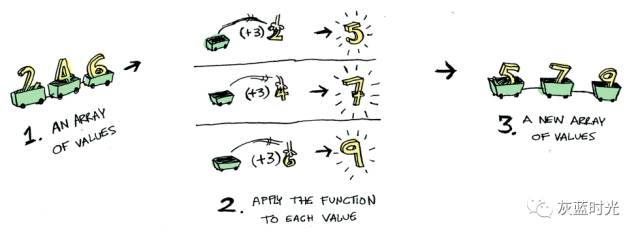
Iterable 也是 functor! 我们可以为其定义 fmap 如下:
fun <T, R> Iterable<T>.fmap(transform: (T) -> R): List<R> =
this.map(transform)好了,好了,最后一个示例:如果将一个函数应用到另一个函数上会发生什么?
{x: Int - > x + 1}.fmap {x: Int -> x + 3}这是一个函数:

这是一个应用到另一个函数上的函数:
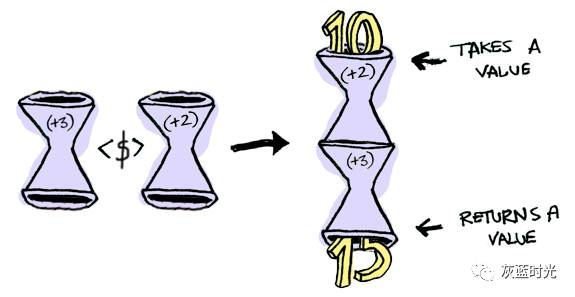
其结果是又一个函数!
> fun <T, U, R> ((T) -> U).fmap(transform: (U) -> R) =
{ t: T -> transform(this(t)) }
> val foo = {x: Int -> x + 2}.fmap {x: Int -> x + 3}
> foo(10)
15所以函数也是 functor! 对一个函数使用 fmap,其实就是函数组合!
Applicative
Applicative 又提升了一个层次。 对于 Applicative,我们的值像 Functor 一样包装在一个上下文中:

但是我们的函数也包装在一个上下文中!
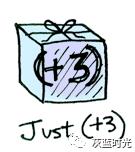
嗯。 我们继续深入。 Applicative 并没有开玩笑。 Applicative 定义了 (*)(在 Haskell 中是 <*>),它知道如何将一个 包装在上下文中的 函数应用到一个 包装在上下文中的 值上:
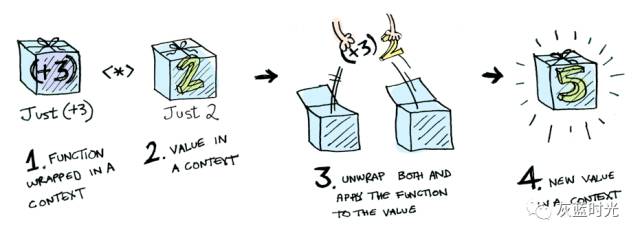
即:
infix fun <T, R> Maybe<(T) -> R>.`(*)`(maybe: Maybe<T>): Maybe<R> =
when(this) {
Maybe.`Nothing#` -> Maybe.`Nothing#`
is Maybe.Just -> this.value `($)` maybe
}
Maybe.Just {x: Int -> x + 3} `(*)` Maybe.Just(2) == Maybe.Just(5)使用 (*) 可能会带来很多有趣的情况。 例如:
infix fun <T, R> Iterable<(T) -> R>.`(*)`(iterable: Iterable<T>) =
this.flatMap { iterable.map(it) }有了这个定义,我们可以将一个函数列表应用到一个值列表上:
> listOf<(Int) -> Int>({it * 2}, {it + 3}) `(*)` listOf(1, 2, 3)
[2, 4, 6, 4, 5, 6]
这里有 Applicative 能做到而 Functor 不能做到的事情。 如何将一个接受两个参数的函数应用到两个已包装的值上?
> {y: Int -> {x: Int -> x + y}} `($)` Maybe.Just(5)
Just(value=(kotlin.Int) -> kotlin.Int) // 等于 `Maybe.Just {x: Int -> x + 5}`
> Maybe.Just {x: Int -> x + 5} `($)` Maybe.Just(4)
错误 ??? 这究竟是什么意思,这个函数为什么包装在 JUST 中?Applicative:
> {y: Int -> {x: Int -> x + y}} `($)` Maybe.Just(5)
Just(value=(kotlin.Int) -> kotlin.Int) // 等于 `Maybe.Just {x: Int -> x + 5}`
> Maybe.Just {x: Int -> x + 5} `(*)` Maybe.Just(3)
Just(value=8)Applicative 把 Functor 推到一边。 “大人物可以使用具有任意数量参数的函数,”它说。 “装备了 ($) 与 (*) 之后,我可以接受具有任意个数未包装值参数的任意函数。 然后我传给它所有已包装的值,而我会得到一个已包装的值出来! 啊啊啊啊啊!”
> {y: Int -> {x: Int -> x + y}} `($)` Maybe.Just(5) `(*)` Maybe.Just(3)
Just(value=15)我们也可以定义另一个 Applicative 的函数 liftA2:
fun <T> ((x: T, y: T) -> T).liftA2(m1: Maybe<T>, m2: Maybe<T>) =
{y: T -> {x: T -> this(x, y)}} `($)` m1 `(*)` m2并使用 liftA2 做同样事情:
> {x: Int, y: Int -> x * y}.liftA2(Maybe.Just(5), Maybe.Just(3))
Just(value=15)Monad
如何学习 Monad 呢:
取得计算机科学博士学位。
然后把它扔掉,因为在本节中你并不需要!
Monad 增加了一个新的转变。
Functor 将一个函数应用到一个已包装的值上:

Applicative 将一个已包装的函数应用到一个已包装的值上:
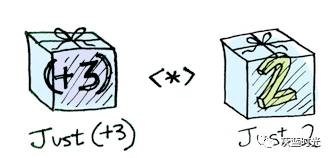
Monad 将一个返回已包装值的函数应用到一个已包装的值上。 Monad 有一个函数 ))=(在 Haskell 中是 >>=,读作“绑定”)来做这个。
让我们来看个示例。 老搭档 Maybe 是一个 monad:
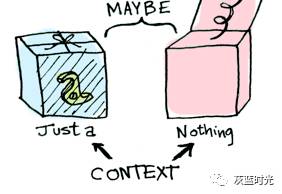
假设 half 是一个只适用于偶数的函数:
fun half(x: Int) = if (x % 2 == 0)
Maybe.Just(x / 2)
else
Maybe.`Nothing#`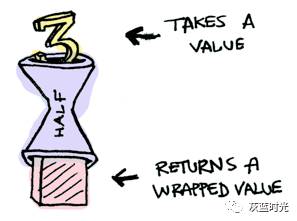
如果我们喂给它一个已包装的值呢?
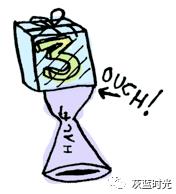
我们需要使用 ))= 来将我们已包装的值塞进该函数。 这是 ))= 的照片:

以下是它的工作方式:
> Maybe.Just(3) `))=` ::half
Nothing#
> Maybe.Just(4) `))=` ::half
Just(value=2)
> Maybe.`Nothing#` `))=` ::half
Nothing#内部发生了什么? Monad 是 Haskell 中的另一个类型类。 这是它(在 Haskell 中)的定义的片段:
class Monad m where
(>>=) :: m a -> (a -> m b) -> m b其中 >>= 是:

在 Kotlin 中,可以认为 Monad 是一种定义了这样中缀函数的类型:
infix fun <T, R> Monad<T>.`))=`(f: ((T) -> Monad<R>)): Monad<R>所以 Maybe 是一个 Monad:
infix fun <T, R> Maybe<T>.`))=`(f: ((T) -> Maybe<R>)): Maybe<R> =
when(this) {
Maybe.`Nothing#` -> Maybe.`Nothing#`
is Maybe.Just -> f(this.value)
}这是与 Just(3) 互动的情况!
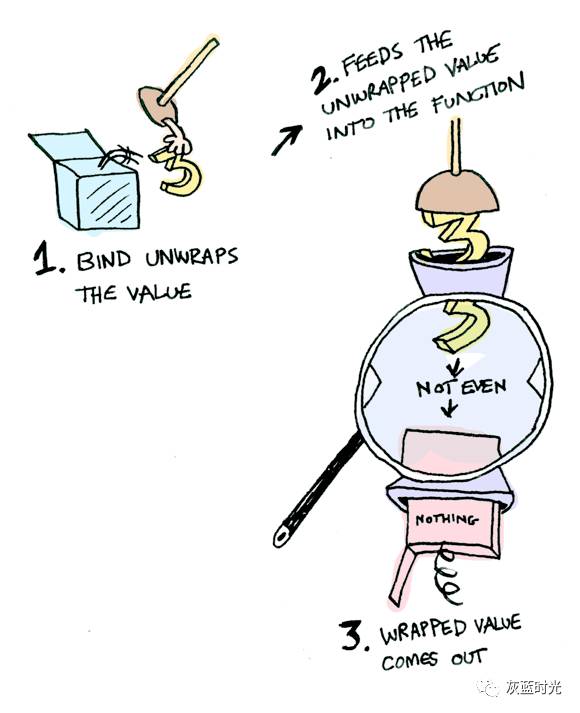
如果传入一个 Nothing# 就更简单了:
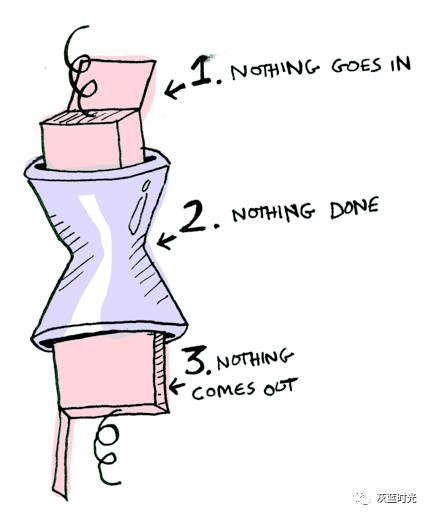
你还可以将这些调用串联起来:
> Maybe.Just(20) `))=` ::half `))=` ::half `))=` ::half
Nothing#

注: Kotlin 内置的空安全语法可以提供类似 monad 的操作,包括链式调用:
fun Int?.half() = this?.let { if (this % 2 == 0) this / 2 else null
}
val n: Int? = 20
n?.half()?.half()?.half()
太酷了! 于是现在我们知道 Maybe 既是 Functor 、又是 Applicative 还是 Monad。
现在我们来看看另一个例子:IO monad:

注: 由于 Kotlin 并不区分纯函数与非纯函数,因此根本不需要 IO monad。 这只是一个模拟:
data class IO<out T>(val `(-`: T)
infix fun <T, R> IO<T>.`))=`(f: ((T) -> IO<R>)): IO<R> =
f(this.`(-`)
具体来看三个函数。 getLine 没有参数并会获取用户输入:

fun getLine(): IO<String> = IO(readLine() ?: "")readFile 接受一个字符串(文件名)并返回该文件的内容:
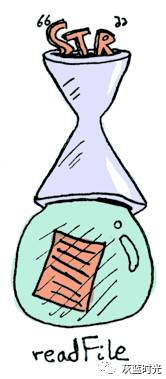
typealias FilePath = String
fun readFile(filename: FilePath): IO<String> =
IO(File(filename).readText())putStrLn 接受一个字符串并输出之:
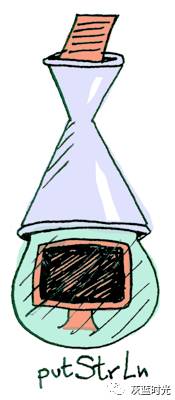
fun putStrLn(str: String): IO<Unit> = IO(println(str))所有这三个函数都接受普通值(或无值)并返回一个已包装的值。 我们可以使用 ))= 将它们串联起来!

getLine() `))=` ::readFile `))=` ::putStrLn太棒了! 前排占座来看 monad 展示! Haskell 还为我们提供了名为 do 表示法的语法糖:
foo = do
filename <- getLine
contents <- readFile filename
putStrLn contents它可以在 Kotlin 中模拟(其中 Haskell 的 <- 操作符被替换为 (- 属性与赋值操作)如下:
fun <T> `do` (ioOperations: () -> IO<T>) = ioOperations()
val foo = `do` {
val filename = getLine().`(-`
val contents = readFile(filename).`(-`
putStrLn(contents)
}结论
(Haskell 中的)functor 是实现了
Functor类型类的数据类型。(Haskell 中的)applicative 是实现了
Applicative类型类的数据类型。(Haskell 中的)monad 是实现了
Monad类型类的数据类型。Maybe实现了这三者,所以它是 functor、 applicative、 以及 monad。
这三者有什么区别呢?

functor: 可通过
fmap或者($)将一个函数应用到一个已包装的值上。applicative: 可通过
(*)或者liftA将一个已包装的函数应用到已包装的值上。monad: 可通过
))=或者liftM将一个返回已包装值的函数应用到已包装的值上。
所以,亲爱的朋友(我觉得我们现在是朋友了),我想我们都同意 monad 是一个简单且高明的主意(译注:原文是 SMART IDEA(tm))。 现在你已经通过这篇指南润湿了你的口哨,为什么不拉上 Mel Gibson 并抓住整个瓶子呢。 请参阅《Haskell 趣学指南》的《来看看几种 Monad》。 其中包含很多我已经炫耀过的东西,因为 Miran 深入这些方面做的非常棒。
译注:Miran 即 Miran Lipovača 是《Haskell 趣学指南》英文原版 Learn You a Haskell 的作者。
在此向 Functors, Applicatives, And Monads In Pictures 原作者 Aditya Bhargava 致谢, 向 Learn You a Haskell 作者 Miran Lipovača 以及 MnO2、Fleurer 等《Haskell 趣学指南》中文版译者致谢。
© 2017 灰蓝天际
点击文末“阅读原文”打开本文对应博客原文;长按扫描下方二维码关注《灰蓝时光》。
以上是关于Kotlin版图解FunctorApplicative与Monad的主要内容,如果未能解决你的问题,请参考以下文章